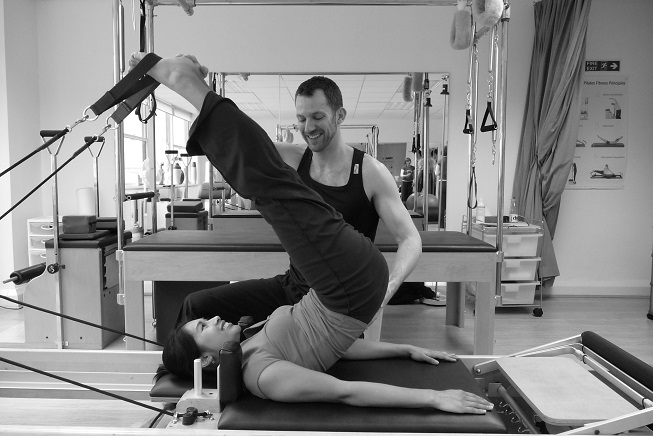 Probably much like a non osteopath’s approach to Pilates I am constantly energised by how deepening my knowledge and experience constantly evolves how I practice.
Probably much like a non osteopath’s approach to Pilates I am constantly energised by how deepening my knowledge and experience constantly evolves how I practice.
I initially started learning to be a Pilates instructor to fill a gap in my knowledge about safe and effective exercise for my clients, really as an adjunct to my osteopathic treatment. Now I see it as a fully integrated part of my treatment and as a result a lot of treatment takes place on the equipment and out of the clinic room.
To explain this further one of the great things about osteopathy is that on a purely mechanical level it seeks out the restrictions to healthy movement and function in the body and helps to remove those barriers. Freedom of movement and essentially communication between different parts benefits the whole. As an example returning movement to a spinal joint will have an effect on the nervous system at that spinal level which can influence many other factors to the areas of the body supplied by those nerves. Such as the regulation of blood flow, resetting of aberrant muscle tone and modulation of pain responses. I initially saw Pilates as a way to empower patients to maintain the range of motion that I was able to return to their bodies during their treatment between the sessions. I felt that there were many benefits to the patients here. During treatments I had to perform less manipulations, so they appreciated that progress was being made. Also it is a very powerful thing to place the responsibility for a client’s recovery and health back in their own hands. Though this is still a very valid way of looking at the relationship between osteopathy and Pilates I now approach things differently.
Many clients present in clinic because they have muscular imbalances that lead to some areas of the body becoming too mobile. Often in response to another area stiffening up, often as a protective bracing reaction to an injury or due to the postural strain that modern life puts our bodies through. Osteopathy is very good at loosening up these tight areas and Pilates can maintain that flexibility. Where osteopathy alone is not so good is providing a strategy to stabilise these overly mobile areas. With clinical experience you realise that bodies are very intelligent and are often bracing an area which may be leading to some symptoms of discomfort in order to prevent the greater evil of uncontrolled unstable and painful movement. Here’s where Pilates is great at providing a great balance of both flexibility and stability. Now my initial goal in treatment is to remove the factors that contribute to irritating such areas, and only looking to mobilise it once the client can effectively stabilise.
As I progress in my education my understanding of the exercises deepens more. Where I used to look at Pilates as a way of returning and maintaining movement I am really starting to appreciate how breathing drives the movement and vice versa and the positive effect this can have. The diaphragm has so many interesting anatomical attachments that if functioning well have a positive effect on our overall health but if they become dysfunctional can contribute to a whole host of problems. It’s all very well to tell a client who sits for long periods of the day to stretch out their hip flexors but if we are doing nothing with the diaphragm that the hip flexors have an anatomical relationship with then we are looking at the body in a reductionist way. As an osteopath I can stretch the hip flexors and the intercostal muscles, release the diaphragm and give my client a home program for breathing exercises. As an osteopath and Pilates instructor I can do all of this but also use the studio equipment to facilitate some amazing stretches and releases to these areas (With the bonus of much less strain on my body) and make every movement on the equipment or mat a breathing exercise. One of the fantastic benefits of Pilates is that it encourages good habits and one of the comments I constantly get from clients is how they start to apply what they do in the studio to their every day activities as their intelligent body starts to re-learn how to move efficiently.
Osteopathy sees the body as an essentially self regulating mechanism but sometimes trauma or mis use can create barriers to this self regulation and pain and dysfunction can be the result. The type of osteopathy I am increasingly attracted to is where the treatment intervention is very gentle and supports the irritated tissues to the point where they are able to regulate again rather than imposing a brief but powerful external force on them, such as the kind of joint manipulation that results in an audible pop. I feel this gentle approach chimes well with Joe’s concept of the spring in the studio equipment acting as extra muscles, in effect off loading the larger prime movers and allowing a client to start to access the stabilisers that will allow the prime movers to function more effectively.
 Both fields of work are very rewarding and if I had only found one of them I feel there is never enough hours in the week to devote deepening my understanding of each, let alone both. However, for me osteopathy and Pilates are a marriage made in heaven. It’s just as rewarding seeing a patient who previously limped into an appointment walking into the next one as getting an e-mail from a client excited that they had managed to touch their toes for the first time in their life!
Both fields of work are very rewarding and if I had only found one of them I feel there is never enough hours in the week to devote deepening my understanding of each, let alone both. However, for me osteopathy and Pilates are a marriage made in heaven. It’s just as rewarding seeing a patient who previously limped into an appointment walking into the next one as getting an e-mail from a client excited that they had managed to touch their toes for the first time in their life!
